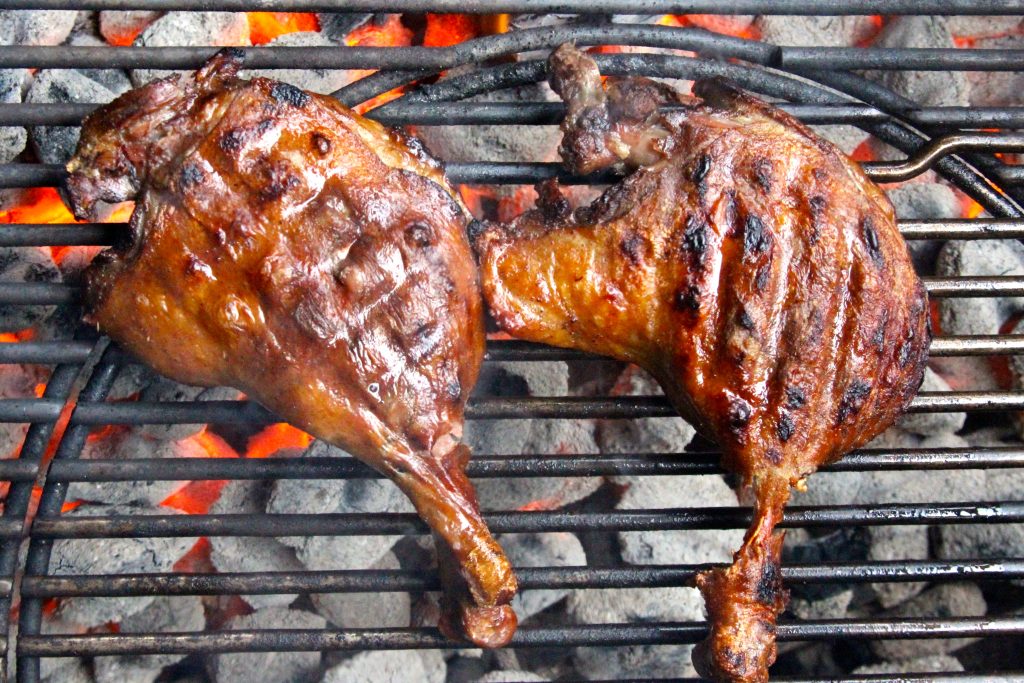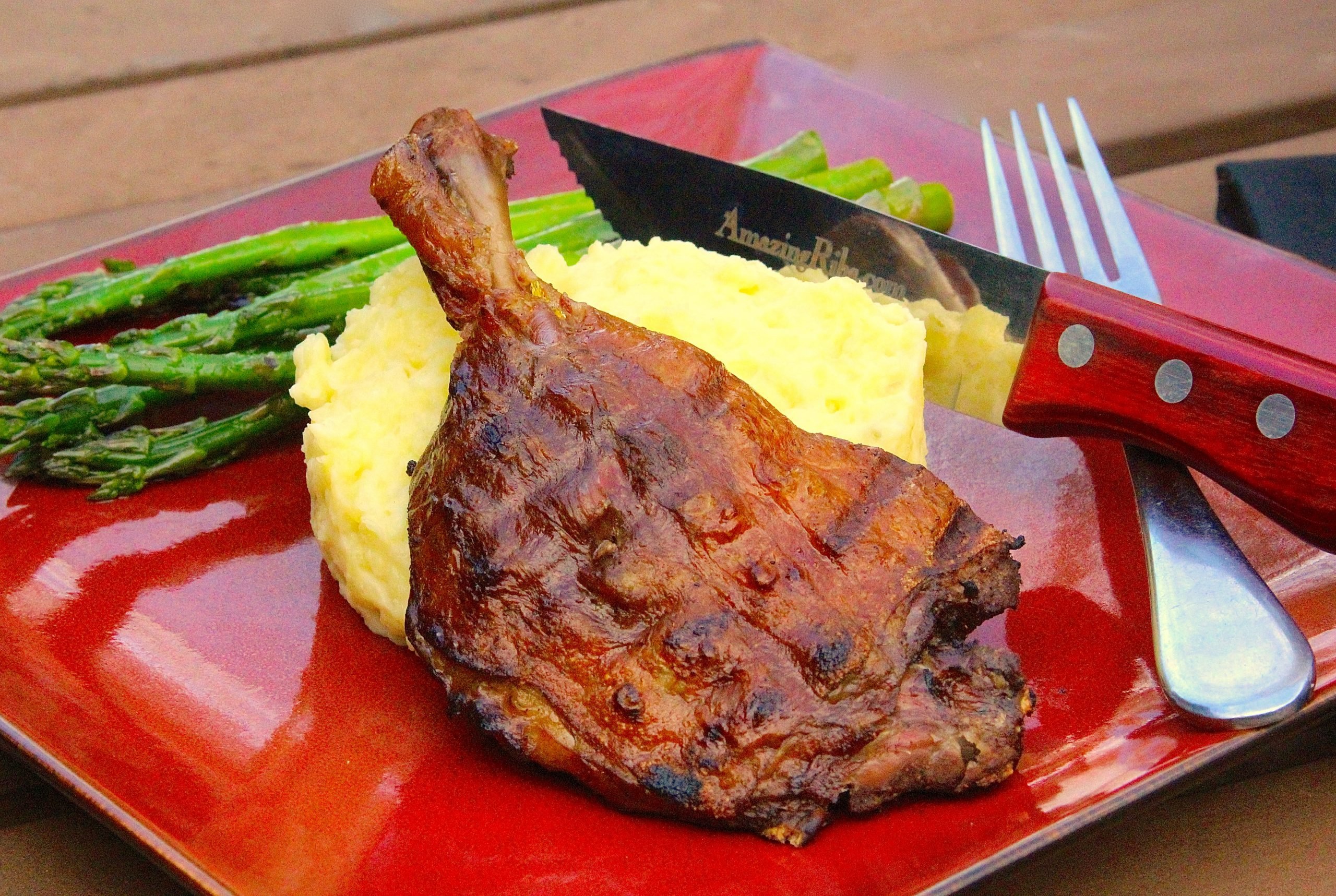This recipe takes duck confit to new heights by combining the moistness and tenderness from sous vide cooking with the smokiness of the grill.
When life hands you lemons, you make lemonade, and when life hands you duck fat, you make duck confit.
Salted and cooked in fat, duck confit (pronounced cawn-FEE] is a French technique originally developed centuries ago as a means of preserving meat without refrigeration. The cooked meat remains submerged in and protected by its own fat. While preserving meat for the winter is no longer a necessity, the preparation method remains popular due to its succulent results. Confit is one of the richest tasting dishes you can get!
Explore the world of Sous Vide Que, the ultimate marriage of water and smoke, by clicking here to download our ebook “Sous Vide Que Made Easy” for $3.99 on Amazon (free Kindle app runs on all computers). Or get the book and others FREE as a member of the AmazingRibs.com Pitmaster Club. Click here to join.
But that doesn’t mean there isn’t room for improvement. Take a look at the salt blend. Most traditional recipes call for a combination of salt, garlic, and fresh herbs but I find that a mixture of salt and Meathead’s Chinese five spice powder adds greater depth to the dish. Instead of curing the meat for 24 hours or longer as most recipes recommend, I limit mine to no more than 12 hours to cut down on the saltiness. It is then sous vide in the duck fat at 145°F (62.8°C) for 24 hours. Note that while we don’t usually recommend adding fats, marinades, spices, or fresh herbs to the sous vide bag (read more about the science behind this recommendation in our Sous Vide Que deep dive ebook here), the addition of the duck fat in this recipe is an essential “exception to the rule” in order to replicate the traditional confit method.
The real innovation in my confit, though, is the AmazingRibs.com’s sous-vide-que method. First, the cured duck legs are sous vide in duck fat for 24 hours at 145°F (62.8°C) to make them extra-moist and tender. This time and temperature is derived from our guide here. At this point, the duck legs can be flash chilled in a 50/50 water bath then refrigerated in the duck fat for several weeks as the fat works as a barrier against bacteria.
Then, to complete the dish, you remove the duck legs from the fat, and reserve the fat for another use (duck fat French fries are fabulous). Set the duck legs aside at room temperature and fire up your grill for 2-zone cooking.
Once the grill has reached an ambient temperature of 325°F (162.8°C) and the duck legs have had time to cool, you give them a bit more flavor with a reverse sear. For some smoke, start the duck legs on the indirect side of the grill and cover the grill for maximum smoke absorption. Once they reach an internal temperature of 155°F (68.3°C), place the duck legs skin side down over direct heat and sear them for about four minutes until the skin is nicely browned and crispy. When they are done, the duck legs can be served whole or shredded for use in a variety of dishes including salads, risotto, dumplings, baked potatoes, and much more.
Makes:
Takes:
Ingredients
- 1 1/2 tablespoons Morton Coarse Kosher Salt
- 2 duck legs
- 1 cup duck fat
- 1 teaspoon Chinese five spice powder
These recipes were created in US Customary measurements and the conversion to metric is being done by calculations. They should be accurate, but it is possible there could be an error. If you find one, please let us know in the comments at the bottom of the page
Method
- Prep. Season both sides of the duck legs with kosher salt. Wrap the duck legs in plastic wrap and refrigerate for six to 12 hours.
- Prepare a sous vide immersion circulator, such as Anova Sous Vide Precision Cooker, according to the manufacturer's instructions and set the water temperature for 145°F (62.8°C).
- Remove the duck legs from the plastic wrap, rinse, and pat dry. Place the duck legs and duck fat in a zipper-lock freezer bag or 1/2 gallon reusable sous vide bag. Carefully submerge the bag in the water bath until most of the air has been removed and then seal the bag. Once the bag is submerged, cook for 24 hours. At this point, the duck legs can be refrigerated in the fat for up to one month before proceeding with the recipe. If you opt to store them for future use, remove the bagged duck legs from the sous vide then submerge the bagged duck legs in a large container filled with a 50/50 mix of ice and water until the meat's core temperature reaches a safe range of 34-38°F (1.1-3.3°C), approximately 15 minutes, before refrigerating.
- Remove the duck legs from the fat, pat them dry, and season with Chinese five spice powder. Let them rest at room temperature as you prepare the grill. Refrigerate the fat for future use.
- Fire up. Prepare a charcoal grill for 2-zone cooking by placing a chimney full of hot charcoal briquets on one side of the grill's charcoal grate in order to create direct and indirect cooking zones. Adjust the smoker or grill vents to bring the temperature to about 325°F (162.8°C) in the indirect zone and add 2 to 3 chunks of your favorite smoking wood to the charcoal for flavor. On a gas grill, adjust the temperature knobs so that one half of the grill is off (the indirect side) and the other half is heated enough to maintain a temperature of approximately 325°F (162.8°C) on the indirect side.
- Cook. Place the duck legs in the indirect zone on the main cooking grate as far away from the heat source as possible. Set the lid on the grill with the top vent fully open and positioned directly above the duck legs in order to force the smoke over and around the meat.
- Allow the duck legs to smoke until they reach an internal temperature of 155°F (68.3°C).
- Place the duck legs skin side down on the hot side of the grill, and grill until the skin is brown and crisp, approximately four minutes.
- Serve. Remove the duck legs from the grill. Serve immediately.




High quality websites are expensive to run. If you help us, we’ll pay you back bigtime with an ad-free experience and a lot of freebies!
Millions come to AmazingRibs.com every month for high quality tested recipes, tips on technique, science, mythbusting, product reviews, and inspiration. But it is expensive to run a website with more than 2,000 pages and we don’t have a big corporate partner to subsidize us.
Our most important source of sustenance is people who join our Pitmaster Club. But please don’t think of it as a donation. Members get MANY great benefits. We block all third-party ads, we give members free ebooks, magazines, interviews, webinars, more recipes, a monthly sweepstakes with prizes worth up to $2,000, discounts on products, and best of all a community of like-minded cooks free of flame wars. Click below to see all the benefits, take a free 30 day trial, and help keep this site alive.
Post comments and questions below
1) Please try the search box at the top of every page before you ask for help.
2) Try to post your question to the appropriate page.
3) Tell us everything we need to know to help such as the type of cooker and thermometer. Dial thermometers are often off by as much as 50°F so if you are not using a good digital thermometer we probably can’t help you with time and temp questions. Please read this article about thermometers.
4) If you are a member of the Pitmaster Club, your comments login is probably different.
5) Posts with links in them may not appear immediately.
Moderators